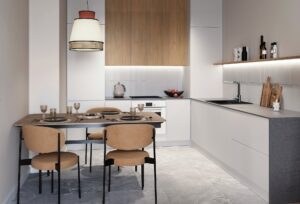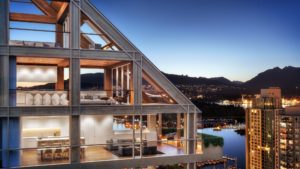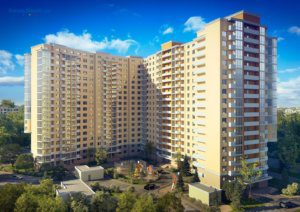
DIM Group put into operation the first stage of Park Lake City after the war, postponed by a quarter the date of delivery of houses in Lucky Land, “Metropolis” and “New Autograph”, the managing partner of DIM Group Alexander Nasikovsky told “Interfax-Ukraine” agency.
“After the beginning of the war we commissioned two houses for 190 apartments, which is 18840 square meters of the first stage of the complex Park Lake City in Podgortsy. We were forced to postpone for a quarter the terms of delivery of houses in our projects: Lucky Land, “Metropolis” and “New Autograph”. We intend to do everything possible to speed up this process and give the keys in the first half of 2023. We thank our investors for their understanding and support”, – said Nasikovsky.
He added that the company has a number of projects in its project portfolio that were scheduled to start in the spring of 2022.
“The war has made its adjustments, now we are directing all efforts to the objects already under construction, and we are doing everything possible to put them into operation as soon as possible. After all, we see an increase in demand for finished housing among our potential buyers, “- said Nasikovsky.
In general, he estimated “dozens of times” decrease in demand compared to the prewar period.
“Our company until Feb. 24, 2022, had 100 to 150 transactions a month, depending on the month and seasonality. Now we’re frankly happy with numbers in the tens. Consumer activity isn’t just down by a factor of ten; it’s almost frozen for months. But people who associate their future only with Ukraine, and for whom the question of buying their own home was relevant before the war and remains so now, return to the choice of their home “- he said.
Nasikovsky recalled that the company had already resumed work on the sites of five projects by June. Among the difficulties he noted a shortage of labor (by his estimates, the number of employees at construction sites has decreased from 20 to 40%), an increase in prices of building materials (by 35%).
“Despite this, developers are trying to keep prices per square meter of housing at levels up to February 24, 2022. In dollars the prices are almost unchanged, but in hryvnia the cost has increased, primarily due to significant exchange rate fluctuations,” – said a representative of the building group.
According to his predictions, in 2023 the cost of primary real estate will grow. This is due not only to the impending growth of demand for new housing, but also the rise in price of construction materials, energy and related resources needed to build houses.
The expert believes that the biggest demand is and will be in the coming years for ready-made accommodation “turnkey”: apartments ready to move in, furnished and equipped.
“There will be a demand for residential complexes with developed infrastructure and everything necessary for comfortable living, so we are actively developing this direction in our projects – ReadyDIM”, – he said.
Another trend is energy-independent solutions not only for individual houses, but also for apartment buildings. In the DIM group of companies since 2022 are working on solutions for new houses of one of the projects on the energy-independent side with alternative solutions for water, electricity and heat.
“We hope to present these projects as early as this year,” Nasikovsky said.
Founded in 2014, the DIM Group consists of six companies that cover all phases of construction.
To date, the company has commissioned 12 houses in six residential complexes. Seven residential complexes of comfort+ and business class are under construction: “Novy Autograph”, “Metropolis”, Park Lake City, Lucky Land, etc.

The updated state construction standards, which ban to arrange hotels, hostels and shops with a total area over 1,000 square meters in the new housing complexes, will come into force from January 1, 2020, a press service of Deputy Minister of Regional Development, Construction, Housing and Utilities Lev Partskhaladze has said.
According to a report, new state construction standards also ban to arrange in the housing complex specialized establishments and enterprises, operation of which can cause air or territory pollution; specialized stores of construction materials, lubricants and other goods (for example, paints, varnishes, flammable substances and materials); workshops for the repair of shoes and household appliances and appliances with an area of over 100 square meters: baths, saunas, production facilities, funeral homes and others.
At the same time, the document permits designing on any floors of the housing complex built-in and built-in attached public premises: shops, cafes, beauty salons, bank branches, etc. Previously, this was permitted only up to the third floor inclusively.
The norm applies exclusively to new construction of the residential buildings. In addition, a mandatory requirement for the placement of such a built-in institution is placing it in a separate fire compartment.
The exception is objects that negatively affect a person in terms of noise, vibration, electromagnetic radiation and radiation. For example, a cafe with a round-the-clock mode of operation, increased noise levels and so on.
BANS, CONSTRUCTION MINISTRY, HOSTELS, HOUSING COMPLEXES, SHOPS, SQUARE METERS

Ukraine’s housing stock as of January 1, 2018 totaled 984.8 million square meters of space, which is 0.7% or 6.9 million square meters more than as of January 1, 2017.
The State Statistics Service has reported that the figures are presented, not taking into account the temporarily occupied territory of Crimea and Sevastopol and certain areas of Donetsk and Luhansk regions.
According to the report, 60.9% or 599.4 million square meters of housing space was located in urban areas.
The share of apartment-type houses was 98.4% of the entire housing stock, while the share of shared apartment-style housing space and housing space in nonresidential buildings was 1.6%.
According to the report, as of January 1, 2018, there were 17 million apartments in Ukraine, and the share of one-room apartments was 19.5%, two-room apartments – 36.6%, three-room apartments – 32.6% and four-room and larger apartments – 11.3%.